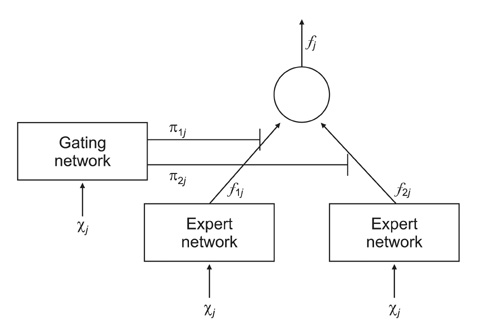Healthc Inform Res.
2012 Mar;18(1):29-34. 10.4258/hir.2012.18.1.29.
A Mixture of Experts Model for the Diagnosis of Liver Cirrhosis by Measuring the Liver Stiffness
- Affiliations
-
- 1Department of Medical Information and Administration, Faculty of Health Science, Jungwon University, Goesan-gun, Korea. smmyoung@jwu.ac.kr
- 2Department of Occupational Therapy, Faculty of Health Science, Jungwon University, Goesan-gun, Korea.
- 3Department of Biostatistics, Yonsei University College of Medicine, Seoul, Korea.
- KMID: 2166615
- DOI: http://doi.org/10.4258/hir.2012.18.1.29
Abstract
OBJECTIVES
The mixture-of-experts (ME) network uses a modular type of neural network architecture optimized for supervised learning. This model has been applied to a variety of areas related to pattern classification and regression. In this research, we applied a ME model to classify hidden subgroups and test its significance by measuring the stiffness of the liver as associated with the development of liver cirrhosis.
METHODS
The data used in this study was based on transient elastography (Fibroscan) by Kim et al. We enrolled 228 HBsAg-positive patients whose liver stiffness was measured by the Fibroscan system during six months. Statistical analysis was performed by R-2.13.0.
RESULTS
A classical logistic regression model together with an expert model was used to describe and classify hidden subgroups. The performance of the proposed model was evaluated in terms of the classification accuracy, and the results confirmed that the proposed ME model has some potential in detecting liver cirrhosis.
CONCLUSIONS
This method can be used as an important diagnostic decision support mechanism to assist physicians in the diagnosis of liver cirrhosis in patients.
Figure
Cited by 1 articles
-
Modified Mixture of Experts for the Diagnosis of Perfusion Magnetic Resonance Imaging Measures in Locally Rectal Cancer Patients
Sungmin Myoung
Healthc Inform Res. 2013;19(2):130-136. doi: 10.4258/hir.2013.19.2.130.
Reference
-
1. Ubeyli ED. A mixture of experts network structure for breast cancer diagnosis. J Med Syst. 2005. 29:569–579.
Article2. Corchado JM, De Paz JF, Rodríguez S, Bajo J. Model of experts for decision support in the diagnosis of leukemia patients. Artif Intell Med. 2009. 46:179–200.
Article3. Jordan MI, Jacobs RA. Hierarchical mixtures of experts and the EM algorithm. Neural Comput. 1994. 6:181–214.
Article4. Jacobs RA, Jordan MI, Nowlan SJ, Hinton GE. Adaptive mixtures of local experts. Neural Comput. 1991. 3:79–87.
Article5. Marsland S. Machine learning: an algorithmic perspective. 2009. Boca Raton (FL): CRC Press.6. Subasi A. EEG signal classification using wavelet feature extraction and a mixture of expert model. Expert Syst Appl. 2007. 32:1084–1093.
Article7. Raman S, Fuchs TJ, Wild PJ, Dahl E, Buhmann JM, Roth V. Infinite mixture-of-experts model for sparse survival regression with application to breast cancer. BMC Bioinformatics. 2010. 11:Suppl 8. S8.
Article8. Kim HS, Kim JK, Park YN, Myung SM, Pang MS, Youn KT, Lee KH, Paik YH, Lee KS, Ahn SH, Chon CY, Moon YM, Han KH. Non-invasive assessment of liver fibrosis by measuring the liver stiffness and biochemical markers in chronic hepatitis B patients. Korean J Med. 2007. 72:459–469.9. Myers RP, Tainturier MH, Ratziu V, Piton A, Thibault V, Imbert-Bismut F, Messous D, Charlotte F, Di Martino V, Benhamou Y, Poynard T. Prediction of liver histological lesions with biochemical markers in patients with chronic hepatitis B. J Hepatol. 2003. 39:222–230.
Article10. McCullagh P, Nelder JA. Generalized linear models. 1983. New York (NY): Champman and Hall.11. Zweig MH, Campbell G. Receiver-operating characteristic (ROC) plots: a fundamental evaluation tool in clinical medicine. Clin Chem. 1993. 39:561–577.
Article




